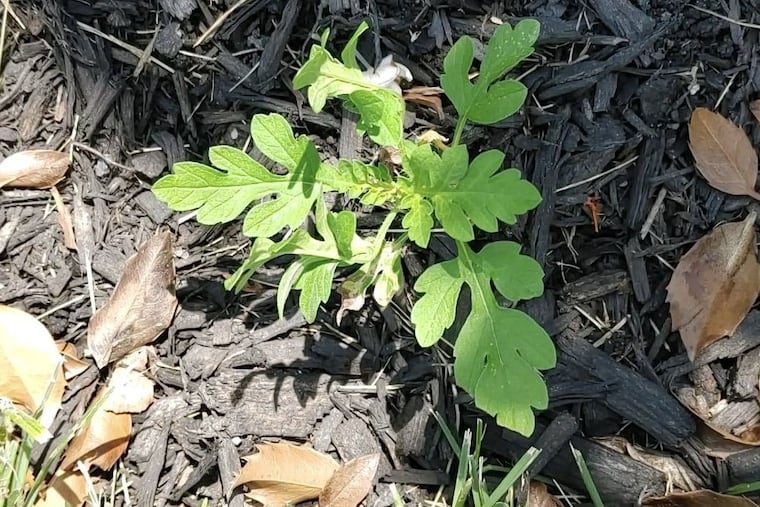Ragweed, itchy-eye, and sneezing season is about to peak in Philly. Here’s what to know.
"We are going to see very high levels," an allergist warns.

Ragweed, that prolific pollen producer and tormentor of millions, is a member of the plant genus Ambrosia, the Greek word for “food of the gods.” While the deific association may be questionable, no one ever accused the gods of being gourmets.
And if history is any indicator, the humble ragweed is about to replenish the gods’ buffet tables.
Although the “very high” and “extreme” pollen levels have yet to appear in the daily counts, the season appears to be off to a precocious start with counts routinely “high,” and any day now they will approach their annual crests.
“Ragweed pollen counts will continue to rise and peak in September,” said Manav Segal, an allergist with Chestnut Hill Allergy and Asthma Associates.
“We’re going to see very high levels,” said Donald Dvorin, an allergist practicing in Mount Laurel and the Philly region’s only National Allergy Bureau certified pollen counter.
For as many as 50 million Americans, by the Environmental Protection Agency’s estimate, that means rounds of itchy eyes and sneezing fits, and allergists such as the Philadelphia Asthma Center’s Marc Goldstein believe the seasons may be getting worse and longer as the planet warms.
» READ MORE: Pollen is poorly measured in America, and that's a problem
What is ragweed?
Ragweed is a prosaic-looking plant that in some variants might quality as a stunt double for cilantro. Its ubiquity and adaptability are legendary.
It is not totally drought-resistant — it did disappear from some Dust Bowl areas during the droughts of the 1930s — but it doesn’t need a lot of water or TLC, according to the experts at Cornell University.
Ragweeds love fertile soils, but don’t need them. Under the right conditions they can grow up to six feet. They grow on roadsides. As for the leftover winter road-salt deposits, they say, bring ‘em on.
Hard to know what they see in each other, but this is the reproductive season, and a single plant can produce up to a billion pollen grains.
» READ MORE: Don't confuse pollen allergies with COVID or other respiratory ailments
They don’t bother most people, but in the allergic they stimulate the immune systems that view the tiny particles as invaders, and induce bodies to respond by sneezing and eye-rubbing.
Ragweed is as tough as it is ubiquitous
The legions of people suffering ragweed symptoms grew tremendously in the first half of the 20th century, for reasons that aren’t entirely clear. It may have been related to increases in urban populations: City folks appear to be more pollen sensitive that their rural counterparts.
Pollen allergies became such a nuisance in New York City that in 1948 it declared war on ragweed.
Ragweed won.
Health officials concluded that after nine years, “By all criteria the effects of Operation Ragweed on the city’s pollen index are not striking.”
» READ MORE: Pollen allergies are examples of how the atmosphere affects our bodies year-round
How we learned that pollen makes people sneeze
Chances are that pollen has been tormenting humans since humans had noses. It is believed that Julius Caesar was afflicted with allergies.
However, it wasn’t until the late 19th century that one Charles Blackley, a British physician and pioneering allergy researcher, identified the connection. Blackley had suffered allergy symptoms for 20 years and was frustrated by the “scanty literature” on the subject.
One day he happened to be traveling on a road when a passing carriage stirred up a cloud of dust, inducing a sneezing fit. Returning to the same area the next day he stirred up a dust cloud and enjoyed another sneezing attack.
He collected a sample of the particles under a microscope lens. What he witnessed “revealed to me the presence of bodies which I now easily recognize as the pollen grains of the grasses.”
He wasn’t done. He went on to conduct various experiments on himself, including applying pollen grains to his eyes and nose to induce allergy symptoms.
Thank you, Mr. Blackley.
What ragweed sufferers can do
If you react to ragweed, doctors advise limiting outdoor time on dry, breezy days when counts are likely high.
On high-pollen days, a mask might help. After you spend time outside, it would be a good idea to shower and change clothes when you come back inside.
Even though the temperatures the next several days are expected to be pleasant, keep the windows closed if possible.
Counts are posted daily by Center City’s Asthma Center, which uses an automated system, between 6 and 7 a.m. Dvorin’s counts, based on a 24-hour sample of what has been captured in his Mount Laurel trap, are available on afternoons Tuesday through Friday.